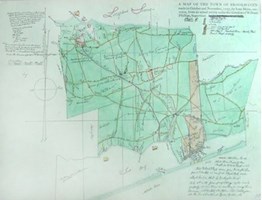|
The requested video is no longer available.
The Land at Mastic A half-century later, in 1718, his son Richard Floyd II (1665-1738), bought over 4,400 acres of property from William "Tangier" Smith of the Manor of Saint George. The property stretched six miles north from Moriches Bay and approximately one mile west from the Mastic or Forge River. It included use rights for the Great South Beach on what is now Fire Island. Richard Floyd II gave this property to his youngest son, Nicoll Floyd (1703-1755). The first Floyd to live on the estate, Nicoll Floyd built the first portion of the "Old Mastic House" in 1724, constructing a two-story, six-room shingled wood frame house. He developed the land into a prosperous plantation, using both slave and free laborers to raise grain, flax, sheep, and cattle. Nicoll Floyd expanded the home as his wealth and his family grew. Nicoll Floyd's oldest son, William Floyd (1734-1821) inherited the property in 1755 at the age of 20. William Floyd became an important plantation owner and was active in local politics. In 1774, he was a delegate from New York in the First Continental Congress. As a member of the Second Continental Congress, 41-year-old William Floyd was the first of the New York delegates to sign the Declaration of Independence on August 2, 1776. After the Revolutionary War, William Floyd (who was in exile from 1777 to 1783) moved back to Mastic, and enlarged the house, making it suitable for entertaining such national leaders as Thomas Jefferson and James Madison. Floyd moved from Long Island to Westernville, New York, in 1803, where he died in 1821, leaving the Mastic property to his son Nicoll Floyd II (1762-1852). 
Subsequent owners included John G. Floyd, Sr. (1806-1881), John G. Floyd, Jr. (1841-1903), and Cornelia Floyd Nichols (1882-1977). These next generations of Floyds continued to operate the plantation and kept the land intact until the 1870s. As the family's business interests shifted from agriculture to politics and other business activities centered in the New York City area, the lands were used for outdoor pursuits like hunting and fishing. During this time approximately 2,200 acres of the property were sold. In 1881, the remaining 2,200 acres was divided among five brothers and sisters, four of whom used their property for summer homes and winter hunting trips. The Old Mastic House was inherited by William Floyd's great-great-granddaughter, Cornelia Floyd, who lived on the property with her children and grandchildren, and donated it to the National Park Service. From 1724 to 1976, eight generations of the Floyd family lived in the Old Mastic House and loved this land.
Today, the "Home Neck" portion of the Estate, approximately 613 acres inherited by Cornielia Floyd, is called the William Floyd Estate and the property is managed by the National Park Service.
|
Last updated: July 1, 2015

